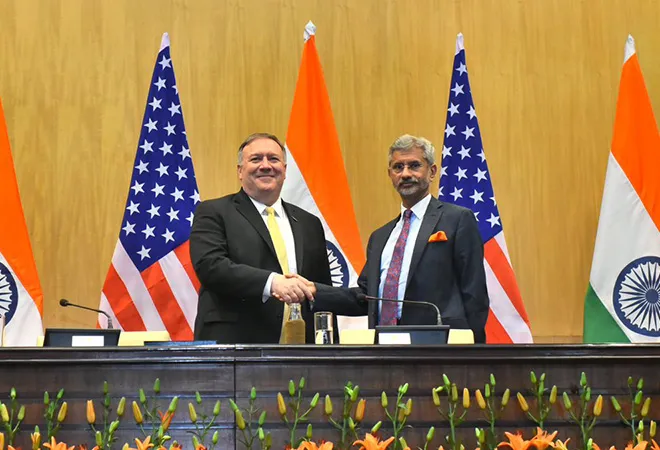-
CENTRES
Progammes & Centres
Location

In the end, it seemed as if the US and India are getting along just fine. US Secretary of State Mike Pompeo’s visit to India has generated a lot of anxiety about the present state of Indo-US bilateral relationship with many claiming that it has hit a rough patch. But in his joint press briefing with External Affairs Minister S Jaishankar, Pompeo was keen the underscore the strategic logic of the partnership once again. Both leaders made it clear that while trade differences exist, they are keen on addressing them effectively as well. Jaishankar said that being the biggest trade partner of India, it was imperative that the two countries would have some differences from time to time. Pompeo, for his part, suggested that both the countries see each other as bigger than just bilateral partners and can help each other all around the world. He was categorical that “US-India partnership is already beginning to reach new heights.”
It is indeed true that the Trump Administration has queered the pitch on a range of issues which were bubbling under the surface for quite some time. Washington wants New Delhi to lower trade barriers. Earlier this month, President Donald Trump terminated India’s designation as a beneficiary developing nation under the key Generalized System of Preference (GSP) trade programme after determining that it has not assured the US that it will provide “equitable and reasonable access” to its markets. Bilateral trade, therefore, will continue to figure prominently in future Indo-US discussions as the two nations try to re-set the terms of their economic engagement.
The Middle East cauldron is boiling and India has equities to preserve in its ties with both the US and Iran. Exemptions from US sanctions to buy oil from Iran have ended for India and India has already started adjusting to new realities. There has been an increase in India's oil imports from the United States outpacing imports from its traditional suppliers in the Middle East. But India would like regional stability in the region and that’s the message it conveyed to Pompeo. As Jaishankar underlined, “energy security is part of it
India's purchase of S-400 Triumf air defence system from Russia was also on the agenda as sanctions have been imposed on Russia by the US. New Delhi’s historical defence ties with Moscow cannot be overlooked and New Delhi has argued that it qualifies for a waiver under the CAATSA (Countering America’s Adversaries Through Sanctions Act). India has showcased the fact more than $10 billion worth of defence deal with the US are in the pipeline so Washington’s role in India’s defence matrix is expanding significantly. India has also made clear that it moving ahead with negotiations on the Industrial Security Annex (ISA) that would support closer defence industry cooperation and collaboration with the US. Jaishankar gave the Russia question a strategic frame when he suggested that India has “many relationships with many countries, many of them are of some standing. They have a history. We will do what is in our national interest. A part of that strategic partnership is the ability of each country to comprehend and appreciate the national interest of the other.”
This is Pompeo's third visit to India by Trump’s Secretary of State and his visit is intended to set the tone for the Trump-Modi talks at next week’s G-20 summit. Pompeo has been bullish on India despite Trump introducing an element of uncertainty in bilateral ties. There have been concerns in India that the US is planning to impose further caps on the H-1B visas that are used by Indians which have already been refuted by Washington. Jaishankar, for his part, has also introduced a sense of pragmatism in the conversation by suggesting that “both the countries are having their own interests. And it is natural to have some conflicts because of that. We will find a common ground using diplomacy. We will hold discussions with the US with a positive approach.”
America, of course, has its own interests in furthering its ties with India, but to deny Indian foreign policy all agency is to do great disservice to India’s growing heft in global politics. Paradoxical though it may sound to many in India, New Delhi primarily wants to enhance its strategic autonomy by deepening its security ties with the US. The biggest challenge to Indian strategic interests today comes from China and India doesn’t have much leverage vis-a-vis it. A strong relationship with the US is the most potent way to ward off the China challenge in the short to medium term. In the long term, this will allow India to develop its comprehensive national power. Despite all the baggage, Mike Pompeo’s visit has succeeded in injecting a renewed vigour in Indo-US bilateral discourse and in Jaishankar he managed to find a partner who is equally focused on delivering practical outcomes. Now it is for Modi and Trump to give the bilateral relationship a strategic purpose at the G-20.
This commentary originally appeared in Mail Today.
The views expressed above belong to the author(s). ORF research and analyses now available on Telegram! Click here to access our curated content — blogs, longforms and interviews.

Professor Harsh V. Pant is Vice President – Studies and Foreign Policy at Observer Research Foundation, New Delhi. He is a Professor of International Relations ...
Read More +